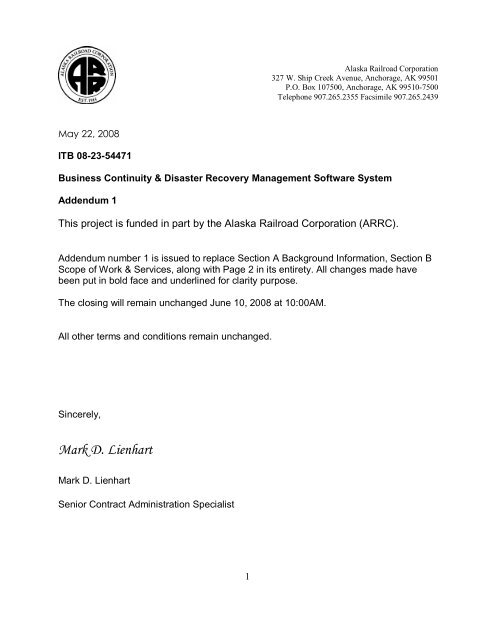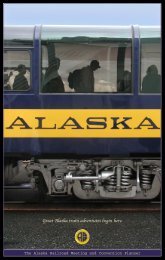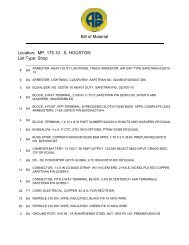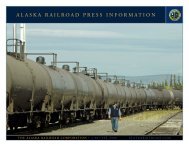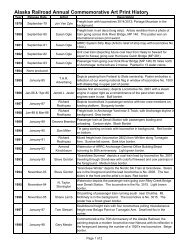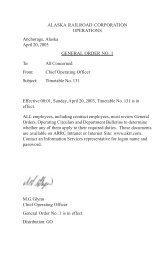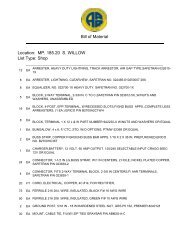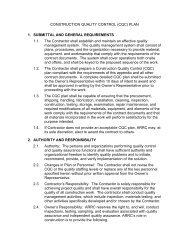Mark D. Lienhart - Alaska Railroad
Mark D. Lienhart - Alaska Railroad
Mark D. Lienhart - Alaska Railroad
Create successful ePaper yourself
Turn your PDF publications into a flip-book with our unique Google optimized e-Paper software.
<strong>Alaska</strong> <strong>Railroad</strong> Corporation<br />
327 W. Ship Creek Avenue, Anchorage, AK 99501<br />
P.O. Box 107500, Anchorage, AK 99510-7500<br />
Telephone 907.265.2355 Facsimile 907.265.2439<br />
May 22, 2008<br />
ITB 08-23-54471<br />
Business Continuity & Disaster Recovery Management Software System<br />
Addendum 1<br />
This project is funded in part by the <strong>Alaska</strong> <strong>Railroad</strong> Corporation (ARRC).<br />
Addendum number 1 is issued to replace Section A Background Information, Section B<br />
Scope of Work & Services, along with Page 2 in its entirety. All changes made have<br />
been put in bold face and underlined for clarity purpose.<br />
The closing will remain unchanged June 10, 2008 at 10:00AM.<br />
All other terms and conditions remain unchanged.<br />
Sincerely,<br />
<strong>Mark</strong> D. <strong>Lienhart</strong><br />
<strong>Mark</strong> D. <strong>Lienhart</strong><br />
Senior Contract Administration Specialist<br />
1
REQUEST FOR PROPOSAL<br />
08-23-54471<br />
The <strong>Alaska</strong> <strong>Railroad</strong> Corporation (ARRC) is soliciting proposals from interested concerns for the<br />
following:<br />
Business Continuity & Disaster Recovery Management Software System<br />
Sealed offers in original and six (6) copies will be received until 10:00 am local time, June<br />
10, 2008. The envelope used for the submittal of your offer shall be plainly marked with the<br />
following information:<br />
1. Offeror’s name.<br />
2. Offer number 08-23-54471<br />
3. Date and time scheduled for the receipt of offers.<br />
4. Sealed Offer: Business Continuity & Disaster Recovery Management<br />
Software System<br />
The ARRC may award a contract resulting from this solicitation to the responsible offeror whose<br />
offer conforming to this solicitation will be most advantageous to the ARRC.<br />
ARRC may reject any or all offers if such action is in the best interest of ARRC, and waives<br />
informalities and minor irregularities in offers received. ARRC may award a contract on the<br />
basis of initial offers without discussions. Therefore, each initial offer should contain the offeror’s<br />
best terms from a cost or price and technical standpoint. Any contract resulting from this<br />
solicitation shall incorporate the Standard Terms and Conditions contained in this solicitation<br />
package.<br />
This Request for Proposal is not to be construed as a commitment of any kind nor does it<br />
commit the ARRC to pay for any cost incurred in the submission of an offer or for any other cost<br />
incurred prior to the execution of a formal contract.<br />
Please direct all responses and/or questions concerning this Request for Proposal to <strong>Mark</strong> D.<br />
<strong>Lienhart</strong>, <strong>Alaska</strong> <strong>Railroad</strong> Corporation, Supply Management, 327 Ship Creek Avenue,<br />
Anchorage, AK 99501, telephone number (907) 265-2355, fax number (907) 265-2439. or email<br />
at lienhartm@akrr.com.<br />
2
SECTION A<br />
BACKGROUND INFORMATION<br />
ARRC Corporate Background<br />
The <strong>Alaska</strong> <strong>Railroad</strong> Corporation (ARRC) is a public corporation of the State of <strong>Alaska</strong><br />
and the last full service (passenger and freight) railroad in the United States, with a route<br />
that runs from Seward and Whittier at tidewater to interior <strong>Alaska</strong> just beyond Fairbanks.<br />
The corporation is headquartered in Anchorage. The <strong>Railroad</strong> employs approximately<br />
950 employees at peak employment.<br />
To support and maintain this transportation network, ARRC’s workforce is spread over a<br />
large geographic area and works in a variety of settings, including offices, mechanical<br />
shops, trains, and along the entire rail system. Although some employees have ready<br />
access to computers, others work in locations without reliable phone or network access.<br />
ARRC is divided into the following divisions:<br />
Executive—Human Resources, Corporate Affairs, Labor Relations, Police and<br />
Security<br />
Finance—Administration, Accounting, including Payroll, and Supply Management<br />
<br />
<br />
<br />
<br />
<br />
<br />
Legal – Risk Management and General Counsel<br />
Operations<br />
o Maintenance—Construction and maintenance of roadway, track<br />
structures, bridges and tunnels; includes MOW<br />
o Transportation—Operation of the trains, including train dispatchers,<br />
brakemen, locomotive engineers, conductors, and trainmasters<br />
o Mechanical—Maintenance of locomotives, freight and passenger railcars<br />
o Passenger Operations—Tour guides, gift shop, and baggage handlers<br />
o Health, Safety, and Environment;<br />
Projects, Engineering, and Grants (PEG)<br />
o Engineering – Engineering and Design<br />
o Grant and Project Administration – Project accounting and support;<br />
federal grant applications and associated grant and project reporting<br />
o Project Management – Design, construction and oversight of ARRC<br />
capital projects;<br />
Information Technology and Signals (ITS)<br />
o Signals – Construction and maintenance of manual and electronic<br />
signalization<br />
o Technology - Hardware and software development and support;<br />
telecommunications support<br />
<strong>Mark</strong>ets, Sales & Service—Freight marketing, logistics, passenger sales and<br />
marketing, customer service, reservations, and ticketing<br />
Real Estate—Management of ARRC-owned land and facilities through permits<br />
and leases<br />
Processes<br />
ARRC earns revenue from transporting freight and passengers, and through real estate<br />
transactions. These operations can be organized into the following categories:<br />
Terminal Operations – all operations occurring in any one of our yards<br />
Train Operations – all operations that comprise train movement along the track<br />
3
Train Asset Management – all operations that comprise logistical management of<br />
assets in support of Train Operations<br />
Asset Maintenance – maintenance of assets owned by ARRC<br />
Real Estate Asset Management – management of all real estate assets owned<br />
and managed by ARRC<br />
Administrative Services – all services provided in support of ARRC operations<br />
Workforce<br />
Each year, ARRC employs approximately 750 to 900 employees. A number of these<br />
positions are seasonal, particularly to accommodate increased passenger and freight<br />
service and infrastructure projects during the summer months. Of these employees,<br />
approximately 600 to 750 are represented by unions.<br />
Business Problems<br />
ARRC has inter-related business processes that are critical to the safe and continuing<br />
operation of trains. These business processes rely heavily on various forms of<br />
technology ranging from computer applications and automated data capture devices in<br />
the field to GPS tracking and state-of-the-art locomotives.<br />
ARRC has initiated a business continuity and disaster recovery (BCDR) planning effort<br />
which requires the deployment of a BCDR software system that will enable efficient and<br />
effective management of BCDR data and processes.<br />
ARRC Standards for Computing Environment<br />
A description of the <strong>Alaska</strong> <strong>Railroad</strong> Corporation computing environment standards<br />
follows describing the desired or acceptable technologies for responding to this Request<br />
for Proposal. New business applications should be built upon and use modern<br />
technologies to the maximum extent feasible.<br />
Network<br />
TCP/IP network<br />
WAN connection speeds of 56k at low-end and up to T1 (1.5Mb) to most remote<br />
areas (e.g., Fairbanks). Within Anchorage bowl, bandwidth is T1 or better<br />
XML and usage of Oracle InterConnect and WebSphere MQ, SQL calls, and APIs<br />
are currently supported<br />
Web Services in addition to Service-Oriented Architecture (SOA) are currently<br />
supported<br />
Domain & Server Hardware and Operating Systems<br />
<br />
<br />
<br />
<br />
Domain: Netware NDS<br />
Server Hardware: HP DL380, 2+ GB RAM, 2+ GHz, RAID, redundant power supply<br />
(with Virtualized Services) (Optional: IBM Power Platform (iSeries/pSeries) 2+ GB<br />
RAM, 2+ GHz, RAID, redundant power supply)<br />
Application Server Operating System: Linux (Optional: WinX, AIX (for IBM Power<br />
Platform))<br />
Database Server Operating System: Linux (Optional: WinX, AIX (for IBM Power<br />
Platform))<br />
4
Server Software<br />
<br />
<br />
<br />
<br />
<br />
<br />
Database: Oracle 10gR2 (Optional: DB2/400 version 5.x) (MS SQL will be<br />
considered as well)<br />
Web: Apache (Optional: Microsoft IIS, Other)<br />
Email: Novell GroupWise/SMTP<br />
Report Writer: Crystal Reports<br />
Remote Connections: Cisco VPN. Cisco VPN required for Internet connectivity<br />
Financial System: SSA Global (formerly Infinium)<br />
Desktops<br />
Desktops are HP dc7300, 2.4-3.2 GHz, 512MB -1GB. Standard software configuration<br />
includes:<br />
Windows XP<br />
MS Office XP<br />
Adobe Acrobat Reader<br />
Internet Explorer 7+<br />
Browser-based applications should be usable at 1024x768 resolution (other<br />
resolution specifications will be considered)<br />
5
SECTION B<br />
SCOPE OF WORK & SERVICES<br />
Scope of Work<br />
The goal of this project is to acquire a fully functional, fully operational BCDR<br />
Management System. Vendors are invited to propose a Commercial Off-The-Shelf<br />
(COTS) software solution that will be installed on computers at ARRC or hosted on<br />
computers outside of its network.<br />
The scope of work includes provision of a software solution and associated services to<br />
support configuration rollout and maintenance. The software solution requirements are<br />
described below in the Product Scope. The service requirements are described next<br />
under Scope of Services<br />
Product Scope<br />
The proposed software solution shall meet the following Technical and Functional<br />
requirements.<br />
Technical Requirements<br />
System Architecture Database<br />
Utilize a client server or Web browser for the primary user interface.<br />
Provide browser support for Internet Explorer 7.0+.<br />
Application forms must display all critical fields on a minimum screen resolution<br />
of 800 x 600.<br />
Application server operating system are AS400 (i5/OS), Unix/Linux, or Windows<br />
2003.<br />
Inter-process communication E-messaging (MAPI, SMTP) Integration with email<br />
server Novell Groupwise.<br />
Database<br />
The product is required to be data-element based and not document-based.<br />
The product maintains the various plans through data points and not an uploaded<br />
document.<br />
Use Oracle 10g or DB2/400 version 5.x as the database.<br />
Provide documentation of the systems components, including a database entity<br />
relationship diagram (ERD) and process diagrams.<br />
Support for data import (for seeding initial system data wherever possible) and<br />
export/extract.<br />
Allow customer-defined codes or modification of existing codes, without requiring<br />
customization and/or violating the software agreement.<br />
Allow user-defined tables and GUI fields to be created and referenced by the<br />
system via forms and automated routines.<br />
Provide a user interface to easily populate lookup data tables (e.g., calendars,<br />
locations, GL accounts, etc.) with user-defined values.<br />
6
System Security, Reliability and Performance<br />
Client demonstrated system uptime of 99% if hosted solution is proposed.<br />
Support a minimum of 10 concurrent users at one central and seven remote<br />
sites.<br />
Establish user access permissions at the user, user group, menu, screen, and<br />
action level.<br />
Establish pre-defined access permissions such as create, modify, delete, view<br />
only, etc.<br />
Support internal user configuration and external authentication (i.e., system<br />
should authenticate against a corporate single sign-on server yet have the ability<br />
to configure the users with different permissions inside the system).<br />
System administrative functionality includes self diagnostics for error logging,<br />
notification and problem resolution.<br />
Reporting and Outputs<br />
The system should be ODBC-compliant or JDBC-compliant and provide open<br />
access to all data to facilitate custom reporting via SQL queries or third-party<br />
reporting tools.<br />
Provide report scheduling capability with multiple report delivery options such as<br />
local or network printer, fax, e-mail, and save electronically.<br />
Provide the ability for interfaces to produce batch files or data to be extracted via<br />
SQL queries.<br />
Documentation, Training, and Support<br />
Technical documentation must exist for the base product as well as for all<br />
customizations, API’s, or other changes not covered in the base product<br />
documentation. This is to be provided at a minimum with each major release.<br />
Provide either online or onsite training.<br />
Online help capabilities to supplement the user training and documentation along<br />
with resolving and understanding user errors.<br />
Established customer support organization that is available during <strong>Alaska</strong> hours<br />
for business operations and in an emergency available within 15 minutes of the<br />
call.<br />
Defined process for vendor maintenance and modification.<br />
Functional Requirements<br />
The application must provide the following capabilities:<br />
Data Collection and Storage:<br />
Facilitate the assimilation of data per established industry standard BCDR<br />
guidelines that are incorporated into the work processes inherent in the<br />
application.<br />
Work allocation, scheduling and progress monitoring capabilities to assign data<br />
definition tasks to user groups throughout the organization<br />
Plan Development<br />
Automatic generation of plans and assessments based on data collected.<br />
Develop plans for simulation exercises separate from those from actual events.<br />
7
Plan Implementation<br />
Work management addressing task allocation, communication, resource<br />
management and progress monitoring for exercises and for actual events that<br />
require the plan to be implemented.<br />
Capture and maintain a historical record of plan implementations including, at a<br />
minimum, a record of planned vs. actual activities and associated schedule and<br />
resource information.<br />
Generate performance reports to reflect the completeness of the plan and level<br />
of success during the execution of the plan.<br />
Communication to users through customizable alerting and notification.<br />
Plan Maintenance<br />
Administrative user interface to manage data, users, user features, access<br />
security, and utilities to minimally import/export data and backup/restore the<br />
database.<br />
Monitor the history of plan maintenance, current status of plans, plan verification,<br />
and user training.<br />
Predefined reports in addition to the ability to generate reports to support the<br />
maintenance of the plan.<br />
8
Scope of Services<br />
As part of the scope of services, the vendor must understand that they will be partnering<br />
with ARRC in the development of the deliverables related to rollout of this system. The<br />
service areas and vendor deliverables are noted below.<br />
Project Management<br />
Project Management for the configuration and rollout of the system. Deliverables<br />
include:<br />
Work Breakdown Structure and procedures for the Installation, Configuration and<br />
Maintenance/Upgrade plans<br />
Hardware & Software Environment Specification<br />
System Configuration<br />
Configuration of the system as required for ARRC functional and BCDR process needs<br />
Final Configuration Specification defining system settings and describing the<br />
rationale that correlates the settings to the ARRC process<br />
System configuration guide detailing the setting options and descriptions<br />
Testing<br />
ARRC will test the system, based on guidance from the vendor. This guidance should<br />
clearly define the testing strategy and responsibilities, as applicable.<br />
Test Plan and Test Cases<br />
List of known issues/ bugs, planned fixes/patches<br />
Training<br />
Preliminary training for a core group of users must be provided after the initial software<br />
installation If available, Web-based and/or computer-based training is acceptable. If<br />
Web-based and/or computer-based training is not available, the vendor must offer onsite,<br />
instructor-led preliminary training.<br />
System Administrator training and training materials<br />
End User training sessions for all other initial users of the system<br />
Support and Maintenance<br />
The successful vendor will provide ongoing support and maintenance for their product.<br />
Service Level Agreement, if applicable<br />
Support contact information<br />
Procedures for reporting critical incidents and/or application faults and submitting<br />
support requests or self-service queries<br />
Definition of how critical incident and/or applications faults will be resolved and the<br />
time frames for resolution<br />
Procedures and available schedules for application upgrades.<br />
Business Continuity and Disaster Recovery Plan if a hosted-solution<br />
9


